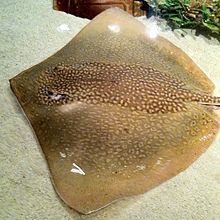
Whitespotted whipray

| Whitespotted whipray | |
|---|---|

| |
| Scientific classification | |
| Domain: | Eukaryota |
| Kingdom: | Animalia |
| Phylum: | Chordata |
| Class: | Chondrichthyes |
| Subclass: | Elasmobranchii |
| Order: | Myliobatiformes |
| Family: | Dasyatidae |
| Genus: | Maculabatis |
| Species: | M. gerrardi
|
| Binomial name | |
| Maculabatis gerrardi (Gray, 1851)
| |
| Synonyms | |
| |
The whitespotted whipray or sharpnose stingray (Maculabatis gerrardi) is a species of stingray in the family Dasyatidae. It is found in coastal regions including estuaries, in the Indo-Pacific, and has also been recorded in the Ganges River.[2] It reaches a maximum disc width of 2 m (6.6 ft). As presently defined, it is probably a species complex.[3]

Etymology
The Stingray is named in honor of Edward Gerrard (1810-1910), a taxidermist at the British Museum of Natural History, who with his shark and ray identifications assisted Gray.[4]

References
- ^ Sherman CS, Ali M, Bin Ali A, Bineesh KK, Derrick D, Dharmadi, Elhassan I, Fahmi, Fernando D, Haque AB, Jabado RW, Maung A, Seyha L, Spaet J, Tanay D, Utzurrum JAT, Valinassab T, Vo VQ, Yuneni RR (2020). "Maculabatis gerrardi". IUCN Red List of Threatened Species. 2020: e.T161566A175219648. doi:10.2305/IUCN.UK.2020-3.RLTS.T161566A175219648.en.
- ^ Ishihara, H. & Taniuchi, T. & Tanaka, Sho & Srivastava, M.P. (1998) Investigation of the freshwater elasmobranchs in the River Ganges. In Adaptability and conservation of freshwater elasmobranchs. Report of Research Project, Grant–in–Aid for International Scientific Research(Field Research) in the financial year of 1996 and 1997: 41–55
- ^ Froese, Rainer; Pauly, Daniel (eds.). "Maculabatis gerrardi". FishBase. October 2008 version.
- ^ Christopher Scharpf & Kenneth J. Lazara (22 September 2018). "Order MYLIOBATIFORMES (Stingrays)". The ETYFish Project Fish Name Etymology Database. Christopher Scharpf and Kenneth J. Lazara. Retrieved 13 February 2022.
- Last, P.R. and L.J.V. Compagno, 1999. Dasyatididae. Stingrays. p. 1479-1505. In K.E. Carpenter and V.H. Niem (eds.) FAO species identification guide for fishery purposes. The living marine resources of the Western Central Pacific. Vol. 3. Batoid fishes, chimaeras and bony fishes part 1 (Elopidae to Linophrynidae). FAO, Rome.

See what we do next...
OR
By submitting your email or phone number, you're giving mschf permission to send you email and/or recurring marketing texts. Data rates may apply. Text stop to cancel, help for help.
Success: You're subscribed now !

